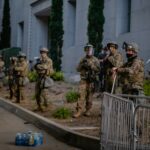Across the Indo-Pacific, the US and its allies face rapidly evolving security challenges. China is determined to field a “world-class military” by 2049 and seeks to use both hard and soft power to coerce America’s friends, intimidate its partners, and push the US from the region. North Korea continues to test missiles, build nuclear weapons, and issue bombastic threats against Seoul, Tokyo, and Washington. Russia also periodically seeks to remind the US and its allies that it, too, is a Pacific power. It regularly sends strategic bombers and fighter aircraft into US, Japanese, and South Korean air defense identification zones and airspace and has started conducting joint “naval patrols” (to include one recently circumnavigating Japan) with China. Moreover, its unjustified and unprovoked war on Ukraine casts a pall extending well beyond Europe. Defiant of international law and increasingly prepared to bluster, bully, and coerce any actor — state or non-state — that seeks to oppose them within the region, these governments pose serious threats to US and allied efforts to maintain a free and open Indo-Pacific.
The tumult of recent years has left Indo-Pacific allies with searching questions about their region and the long-term reliability of the US.
In response to these challenges, the recently released “Indo-Pacific Strategy of the United States” puts forward the concept of “integrated deterrence” as critical to both defending US allies and changing the decision calculus of regional adversaries. As described by Secretary of Defense Lloyd Austin and his leadership team, integrated deterrence is an important evolution and adaptation of US defense and deterrence posture to address contemporary threats around the globe, including the Indo-Pacific.
Austin has stated that deterring coercion and armed aggression in the region will require the US military to find new synergies and field innovative capabilities improving its ability to project power across the region. But in major addresses delivered in Honolulu in April 2021 and Singapore in July 2021, he also emphasized that integrated deterrence is not solely an internal imperative and will require unprecedented levels of diplomatic and defense cooperation between the US and its Indo-Pacific allies.
Austin’s speeches and the idea of integrated deterrence has met with cautious optimism — and some questions of scope and implementation — from US allies in the region. Early returns on steps to bolster US and allied conventional forces in the Indo-Pacific, to include permanently stationing US helicopters previously rotated through South Korea, adding rotations of US military aircraft to Australia, and the AUKUS agreement representing a long-term US–UK–Australia investment to provide Canberra with new attack submarines, are favorable. But in the absence of renewed attention to US nuclear security commitments, which have long represented a cornerstone element of Washington’s defense relationships with Japan, South Korea, and Australia, the US and its closest friends in the Indo-Pacific will find it challenging to build a truly integrated approach to common security threats.
AN INCREASED NEED FOR NUCLEAR (RE)ASSURANCE
US nuclear security commitments provide a “nuclear umbrella” over allies facing nuclear-armed adversaries via a US promise to impose severe costs (up to and potentially including nuclear strikes) on any aggressor launching a nuclear attack or otherwise posing an “extreme circumstances” threat against a state covered by this pledge. There are two sides to these commitments — and two audiences. To be effective they must extend deterrence against regional adversaries through the threat of cost imposition while also simultaneously assuring US allies they are protected from harm.
The US extended deterrence posture in the Indo-Pacific remains robust thanks to the strength and reach of the US nuclear triad. As Washington asks its Indo-Pacific allies to integrate their diplomacy and defense strategies more tightly with the US, however, there are three reasons it should bolster its approach to allied assurance. The first has to do with evolving nuclear threats. Second is about using US’ declaratory policy to build trust with allies, while the third focuses on the ability to wrestle existential threats effectively with allies.
Reason #1: Evolving regional nuclear threats
First, integrated deterrence will need to address allied concerns that the Indo-Pacific security environment is deteriorating due to a combination of new and evolving threats. These prominently include nuclear threats, with China, North Korea, and Russia all investing significant resources in improving their nuclear arsenals. Yet, despite the increased salience of the US nuclear umbrella to allied security, the US has sent mixed signals about its regional nuclear deterrence posture.
For 16 years, US leaders, diplomats, and military officials lauded the “continuous presence” of US strategic bombers stationed on rotations at Andersen Air Force Base in Guam as providing visible proof of US nuclear security commitments to its Indo-Pacific allies. But in April 2020, Air Force Global Strike Command (AFGSC) announced the continuous presence mission was ending and the aircraft were immediately returning to bases in the US. While a Command spokesperson stated the bombers would continue their deterrence role, keeping adversaries off-balance by using multiple Indo-Pacific locations during future visits to the region, no reference was made to the previous mission’s long association with the US nuclear umbrella. The sudden departure of the bombers at a time of cratering US-China relations, additional North Korean missile testing, and the upheaval of the ongoing COVID pandemic left some allied commentators wondering if the risks and costs of Indo-Pacific strategic competition were proving to be too much for the US.
The seemingly abrupt end of “continuous presence” and the bad optics of a capability long cited as central to US regional nuclear security commitments literally flying out of the region (and using the callsign “SEEYA”) raise questions about whether US strategic communications efforts in the region devote sufficient time and attention to the needs of allied assurance. In recent months, the US has sought to allay allied concerns by regularly operating bombers in the Indo-Pacific, including during major regional combined military exercises. This is a positive step, but bringing about a closer alignment between US and allied deterrence strategies requires doing more to address the lengthening nuclear shadow over the region. One such measure would be to ensure that US strategic communications are better coordinated. Emphasizing the enduring protection provided by the US nuclear umbrella will deliver a strong assurance message to allies and a corresponding deterrence signal to adversaries, and will facilitate better integration on combined approaches to deterrence.
Reason #2: Building trust with allies
The degree to which allied leaders in the Indo-Pacific will be willing to join the US in using every “military and non-military tool in the toolbox” to develop integrated deterrence strategies will depend on how much they trust Washington to take significant risks to protect its friends. US nuclear security commitments epitomize and legitimize this level of trust.
Washington will find it difficult to advance an integrated deterrence agenda in the Indo-Pacific if it overlooks or undersells the importance of assuring its non-nuclear regional allies.
By stating its preparedness to launch a nuclear counterstrike against any adversary that executes a nuclear or other form of “extreme” attack against a state under the US nuclear umbrella, the US implicitly puts its own homeland at risk of preemptive or retaliatory nuclear strikes by the nuclear-armed adversaries of its allies. During the Cold War, allied leaders would often ask if the US was truly prepared to defend beleaguered allies abroad if doing so exposed American cities to Soviet nuclear attacks (a question phrased as “Would the United States really trade Pittsburgh for Paris?” by fans of alliteration, but other US and allied cities were also used as examples). This blunt language (which perhaps sounded more elegant in French) belies the fact that, then and now, the US must devote considerable diplomatic capital to assuring allies that no risk, however dire, will dissuade America from protecting its friends.
In the past, US nuclear declaratory policy was expressly phrased with a degree of ambiguity to leave nuclear-armed adversaries uncertain as to what act of major aggression (or threshold of death and destruction) levied against the US or its allies risked catalyzing a US nuclear response. Narrowing or caveating of this language will likely be keenly felt by allies underneath the US nuclear umbrella. Declaratory policy is ultimately a statement of presidential intent. Regardless of how US declaratory policy is phrased in public-facing documents, foreign actors — whether adversaries or allies — are very unlikely to conclude a US president intends to communicate any uncertainty regarding their willingness to employ a devastating nuclear “second strike” following a nuclear attack on the US. Indeed, polling data suggests that the US public would expect and support such a response. Anything other than minor alterations to US declaratory policy (particularly if not carefully coordinated with allies) will be read abroad as reflecting a change in the willingness or readiness of the US to employ nuclear force in circumstances other than attacks on itself (i.e., scenarios where its allies are under assault).
For many US non-nuclear allies, the US nuclear security commitment provides vital protection against an existential threat, a conviction likely heightened by Russian President Vladimir Putin’s repeated rattling of the nuclear saber both before and during the war he is waging on Ukraine. Potential changes to declaratory policy, therefore, should carefully assess the potential impact on deterring adversaries and assuring allies. This should include close consideration of US allies in the Indo-Pacific, whose leaders will be wary of agreeing to closer integration of diplomacy and defense strategies if they wonder whether revisions to US declaratory policy signal Washington is prepared to partly fold up its nuclear umbrella.
Reason #3: Wrestling existential threats together
In seeking to develop integrated deterrence strategies with its Indo-Pacific allies, it will be important for Washington to recognize the latter’s democratic polities are currently wrestling with how to best respond to a complex security environment featuring serious environmental, biological, and human-made threats. Allied domestic debates on national security and weapons of mass destruction remained largely dormant for a generation after the collapse of the Soviet Union. But North Korea’s successful defiance of international sanctions and nonproliferation efforts to test a nuclear weapon led to their return in 2006, and Pyongyang’s continued missile testing coupled with China’s recent qualitative and quantitative expansion of its nuclear arsenal have heightened the urgency of this discourse. In response to these threats, the South Korean public is increasingly supportive of pursuing its own independent nuclear deterrent while Japan debates whether it needs to consider pursuing offensive strike systems to better defend itself against possible North Korean missile strikes.
Realizing a high degree of unity within and between democratic allies on the best ways and means to respond to extreme and far-reaching threats can be challenging. But forging unified positions incorporating a range of ideas and opinions is ultimately a strength of democracies and democratic alliances. During the Cold War, the US and its European allies had to work diligently to navigate sometimes roiling domestic political debates (and major protests) to reach agreement on how to counter Soviet nuclear forces. When NATO established a consensus position, however, such as the dual-track approach to the 1980’s Euromissile crisis, it put forward a powerful deterrence posture that also improved the odds for subsequent diplomatic negotiations. (Conversely, during the same time period a failure to resolve tensions between allied domestic and alliance defense imperatives in the Indo-Pacific precipitated a nearly 35-year rift on security cooperation between the US and New Zealand.)
Allied publics facing nuclear threats are looking for reassurance from the US; if they fail to receive it, they may press their decisionmakers to pursue unilateral options that could seriously complicate US efforts to encourage greater cooperation between its friends in the Indo-Pacific. This could derail US plans to pursue integrated deterrence strategies with its regional allies, underscoring the importance of tailoring assurance messages and actions that can effectively respond to the security concerns of both allied polities and policymakers.
TO BETTER DETER, FIRST ASSURE
Persuading allies to advance side-by-side with the US against all threats requires first convincing them they are fully protected against extreme threats. The tumult of recent years has left Indo-Pacific allies with searching questions about their region and the long-term reliability of the US. Washington will find it difficult to advance an integrated deterrence agenda in the Indo-Pacific if it overlooks or undersells the importance of assuring its non-nuclear regional allies. Bolstering allied assurance will pay dividends by addressing these concerns and smoothing the way for the in-depth discussions needed to jointly craft tightly integrated deterrence strategies.
Justin Anderson is Senior Policy Fellow at the National Defense University Center for the Study of WMD. The views expressed here are those of the author and are not an official policy or position of National Defense University, the Department of Defense, or the US government.




















